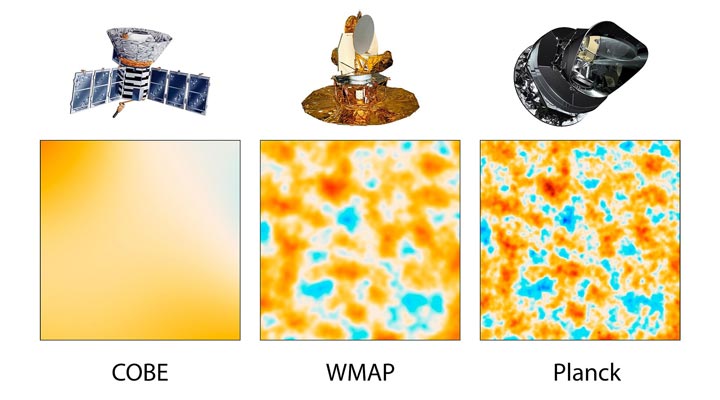

Cosmic Microwave Background (CMB)Microwave observations of the CMB provide a snapshot of the universe when it was roughly 380,000 years old, corresponding to a redshift z ~ 1100. All-sky microwave maps from the DMR (Differential Microwave Radiometer; Smoot et al. 1992; Bennett et al. 1996) instrument aboard the COBE satellite showed definitively that small amplitude intrinsic temperature variations (anisotropies) existed in the CMB, at a level of about 1 in 100000. Subsequent satellite missions with improved frequency coverage, polarization sensitivity, higher spatial resolution and signal-to- noise include WMAP (Wilkinson Microwave Anisotropy Probe: Bennett et al. 2003, 2013) and Planck (Planck I 2013, 2015).  Image Credit: NASA/JPL-Caltech/ESA The three panels above illustrate how the increased spatial resolution achieved with each new generation of instruments has added to our knowledge of the CMB. Each panel shows the same 10 square degree patch of sky, but depicts how the same CMB anisotropies would appear at the resolution of COBE/DMR (1989-1993), WMAP (2001-2010) and Planck (2009-2013) satellite missions.
Concurrent observations from ground-based and suborbital experiments are confined to a fraction of the sky, yet provide important detail at small angular scales. A partial list† of such experiments includes:
Observations of CMB emission at all angular scales are key for comparison with theoretical predictions, as specific physical processes are associated with particular scales: see for example Page et al. (2003) and references therein for descriptions of features in the angular power spectra arising from the primordial CMB anisotropies. Additional late-time induced anisotropy signatures also exist, such as small-scale anisotropies resulting from scattering of CMB photons by hot ionized gas in galaxy clusters (the thermal Sunyaev-Zeldovich, or tSZ, effect). The tSZ effect can be used as a probe of large scale structure which is complementary to optical and infrared galaxy surveys. Experiments with sufficiently high angular resolution, such as Planck, ACT and SPT, have facilitated observations of the tSZ effect on cluster scales. In another important effect, CMB temperature and polarization anisotropies are weakly deflected by gravitational potentials associated with the large-scale distribution of matter in the universe. This weak gravitational lensing of the CMB provides an additional probe of the matter distribution (see for example Planck XVII 2014). †A more complete list may be found at http://lambda.gsfc.nasa.gov/product/expt/ Contributed by the NASA / LAMBDA Archive Team. |

